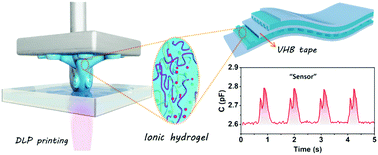3D printing of ionic conductors for high-sensitivity wearable sensors†
Abstract
Transparent conductors with high stretchability are highly desirable for wearable sensors and electronics. However, the existing applications of sensors involving electronic conductors are limited by the significant resistance increase upon deformation and the laborious device fabrication. Herein, we constructed ionically conductive hydrogels using a photopolymerization-based 3D printing technique, and then developed transparent, highly stretchable, and elastic hydrogels into capacitive sensors, enabling sensing of both pressure and strain. The 3D printing of ionic conductors provides an effective and flexible way to manufacture microstructure electrodes, thus greatly simplifying the device fabrication process, and in the meantime endowing the device with high sensitivity and low detection limit. Its superior capabilities are demonstrated by high-fidelity body signal acquisition over multiple skin locations. In addition to providing an approach for preparing high-precision ionic conductors with microstructures, this work also paves the way for the development of a new class of smart electronics and artificial intelligence.

- This article is part of the themed collections: Horizons Community Board Collection: Biosensors and A selection of 2019 articles


 Please wait while we load your content...
Please wait while we load your content...